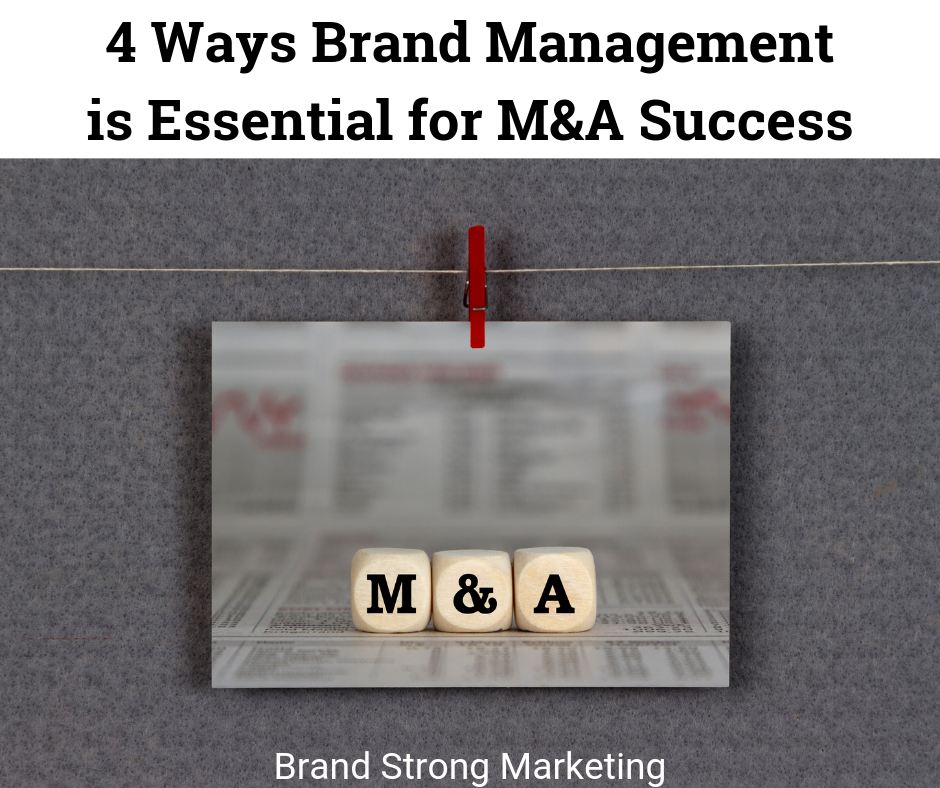4 Ways Effective Brand Management is Essential for M&A Success
 A merger or acquisition can be a successful growth strategy. Access to another firm’s customers, technology, process, and people can accelerate growth. However, it can also cause extreme stress and damage a firm’s brand if handled poorly.
A merger or acquisition can be a successful growth strategy. Access to another firm’s customers, technology, process, and people can accelerate growth. However, it can also cause extreme stress and damage a firm’s brand if handled poorly.
Some typical issues that arise when companies try to integrate are:
- Companies focus internally and lose track of pleasing their customers, causing customers to defect to the competition.
- Employees are demotivated or jump ship. Productivity plummets.
- Executives and employees lack a clear vision for the future of the company. They march in different directions.
- Companies suddenly find themselves with too many brands and not enough resources. Brand equity declines for all brands.
All of these issues combined create confusion, derail the integration, and ultimately result in lost profits and a failed merger or acquisition.
But there is good news!
Companies can keep their eye focused on growth during the integration process through effective brand management. Companies tend to focus on the operational, accounting and systems integration and forget the soft side of an integration. There are people involved and they need communication throughout the process.
A merger and acquisition event is all about change. And change is never easy. But focusing on the brand identity of the organization allows the CEO and executive team to stay focused when making integration decisions.
A company’s identity is comprised of its core values, core competencies, mission and brand promise. It is the voice of the business strategy and often can drive strategic decisions. Will this initiative strengthen our brand? If not, why are we doing it? A company’s ability to execute its strategy and live up to its brand promise determines its success.
Often times in an M&A transaction, this factor is overlooked before, during, and after the transition. And this is a critical mistake.
Brand identity management plays an important role in creating value during the M&A transaction, especially during the integration process. Here are 4 ways effective brand management is essential for M&A success.
Name of the entity
First, the CEO of the new entity should consider the name of the newly merged or acquired organization. Intentional or unintentional name changes send signals on the strategic direction of the merger. How important is this merger or acquisition to the company? What kinds of changes should be expected? How much integration is to be expected? Companies need to think long and hard about what name will carry the organization forward and set up expectations for the changes ahead.
In many small to mid-sized companies, the name of the business carries a large amount of emotional baggage. It is very difficult for a CEO to change the name of a company his or her grandfather founded. But focusing on the brand promise behind the name and how the name will support the company as it grows in the future will help leaders to make this difficult decision.
Integration of two distinct cultures and core values into one new identity
Second, companies must create a plan for the integration of two distinct cultures and core values into one new identity. This can be hard when one firm is acquiring its competitor, for example. The employees have a hard time transitioning from rival status to co-worker.
Whereas the management teams may know each other well from putting together the deal and on-going professional associations, front-line employees may find it nearly impossible to change their way of thinking overnight. The issue requires communication.
This can also be difficult during an international M&A situation. Adding language and cultural differences on top of corporate culture differences can cause a tremendous amount of confusion and frustration during integration. But clearly articulating to employees what the M&A deal will accomplish, and focusing on the brand promise to be delivered to customers around the world, will allow people at all levels of the organization to resolve issues at the local level.
Lack of an Integration/ Communication Plan
Third, even if the management team has agreed on a new name and are assuming a positive potential for merging of cultures, the lack of an integration/communication plan will prohibit forward movement on both fronts.
Several organizations have published studies saying anywhere from 60 – 83% of all mergers fail or are unsuccessful in creating value. There are many reasons for this but one important reason is failure to communicate to all stakeholders how the merger will benefit them. If employees and customers don’t understand how the change is going to affect them, they may react negatively, destroying the value of the merger or acquisition. To avoid that, a smart company communicates the new identity and vision of the new organization throughout the M&A transaction – to employees, customers, board members, investors and the industry.
This allows all stakeholders to understand and assimilate the change, reducing the chaos period that normally follows an announcement. Lost employees, customers or time due to confusion or negative rumors can be avoided.
Evaluating your Brand Assets
Finally, in many M&A situations, companies find they are suddenly the proud owners of a bunch of different brands. However, they don’t have the financial resources to support them all and they don’t know which brands, existing or acquired, have the most equity. Companies need to align their brand assets with the business growth strategies. Making the decisions to revitalize, create or liquidate brands within your portfolio will result in cost savings, greater brand equity, focus, and increased revenue growth. This process can be started even prior to deal close to speed up integration.
By acknowledging the importance of brand identity from the onset, keeping it at the forefront during the process and addressing it as a top priority in the integration of the newly created organization, a company can expect:
- Faster, more efficient integration
- Increased loyalty with employees, customers, suppliers, and other stakeholders
- Cost savings from focusing resources on strongest brand assets as well as avoiding confusion and mistakes during integration
- Consensus on the future vision of the company so all employees are working to deliver the brand identity promise to customers
- Drastic improvements in the chances for a successful integration and a profitable M&A deal.
Give us a call at 847-963-1805 to learn how we have helped firms work through M&A integration issues and increase their chances for successful integration and growth through effective brand management.






